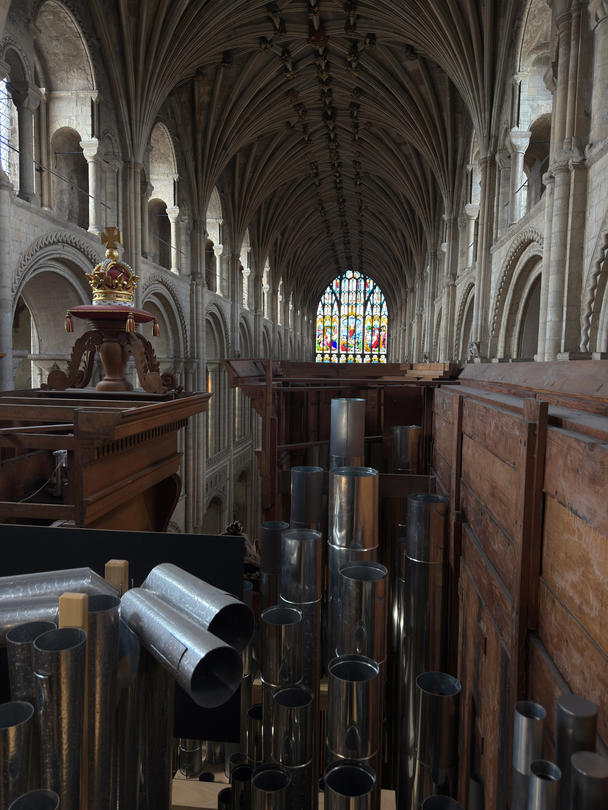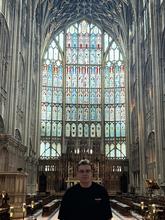The Sound of Tradition: Exploring the Craft of Pipe Organ Building

I have always been drawn to the intersection of music and architecture. Until my summer fellowship through the Streicker International Fellows Program, I had never truly considered what it takes to keep sound alive.

I worked with Harrison & Harrison, a world-renowned pipe-organ building firm based in Durham, England. Upon arriving, I quickly learned that the firm is not driven by profit but rather by a deep commitment to preserving a centuries-old craft and serving the community. This model creates a working environment informed by a passion for the work and an ongoing commitment to tradition. Some builders today even rely only on hand tools passed down for generations. It is not a nostalgic affectation; it is a philosophy. The work matters not only for the sound it produces, but also for its role as a presence in a community.
I spent most of my fellowship in the workshop: casting and shaping metal pipes, cutting wind trunks, planning restoration work in the design office. My favorite days were on site, helping inspect and care for the organs themselves. These site visits brought me to some of the most important cathedrals in England; others led to far smaller parishes. In a village church in Stanhope, my team was welcomed by a former Bishop of Salisbury. Having once presided over one of England’s most renowned cathedrals, he had retired to serve this rural congregation. His devotion to both the grand and the modest communities echoed the very ethos I had witnessed working for Harrison & Harrison: the idea that dignity and care are not reserved for the prestigious but applied equally to every instrument. The firm maintains some of the most distinguished organs in the world but also dedicates itself to churches that struggle to raise funds. Before my fellowship, I had not thought much about what motivated craftmanship; I assumed that fiscal considerations dictated priorities. While looking over the company estimation process, I wondered whether specific optimization might make the business more cost-efficient. But I realized that efficiency is not the end goal. The firm does not exist to maximize profit. It exists to preserve traditions, to keep instruments alive for their communities. That perspective reshaped how I thought about my work. While practical improvements are necessary, they must serve a greater purpose.
By the end of the summer, my work had carried me into incredible spaces: I looked down upon the quire at Ely Cathedral; I explored the triforium of Norwich Cathedral; I tuned the reeds of Westminster Abbey; I helped install a renovated organ in St. John’s College, Cambridge. These moments taught me how this tradition contributes to something much larger than the instrument itself.

While I do not plan to become an organ builder, the fellowship showed me how disciplines like architecture and music can intersect in unusual ways. It reminded me that craftsmanship and community are inseparable. It taught me to look at my projects as contributions to a communal good. Hearing my colleagues share memories of their favorite organs, some of which featured pipes made over a century ago, encountering the quirks and histories of local organs — this experience gave me more than a set of technical skills. Ultimately, this fellowship established a personal understanding of why I am drawn to architecture and music in the first place; not only for the beauty of the art itself, but also for its ability to sustain tradition and create spaces where people come together.
The Streicker International Fellows Program was established in 2015 by John H. Streicker ’64 to provide undergraduate students the opportunity to design their own summer internship in collaboration with organizations outside of the United States.
Since its inception, the program has supported nearly 150 students in pursuing self-designed internships across the globe. Fellows undertake projects that align with their academic and professional goals while engaging in cross-cultural exchange that deepens their understanding of our interconnected world.
“In his heart, our father was an academic adventurer who loved the lessons afforded through global travel,” said Michael Streicker ’99. “He designed the Fellows Program as a way for students to pursue their curiosities across cultures. He would be extremely pleased to see the development of the program and the wonderful contributions its students have made.”
This summer, 22 students were named Streicker International Fellows to pursue internships across 16 countries and in industries including global health, human rights and advocacy, finance and more.
